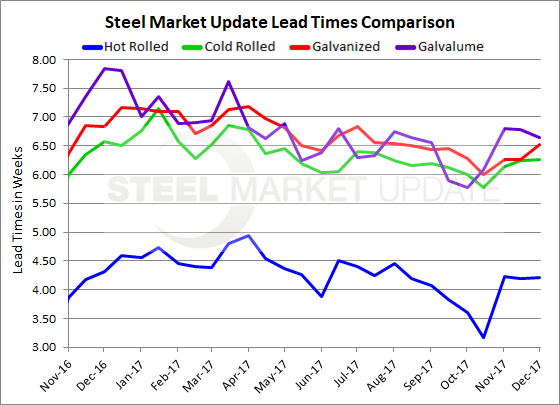SMU Data and Models

Steel Mill Lead Times: Little Change
Written by Tim Triplett
December 7, 2017
Mill lead times have seen little change in the past month, according to the latest data from Steel Market Update’s flat roll market questionnaire, despite the price hikes announced by the mills two weeks ago. One of the key indicators tracked by SMU, lead times reflect the activity at the mills and the order levels they are seeing from their customers. Had the market balked at the price hikes, with buyers pulling back on orders, one would have expected lead times to shorten. Therefore, the lack of change could be interpreted as a positive sign for demand.
Hot rolled lead times averaged 4.21 weeks in early December, the same as last month, but a week longer than in mid-October when HRC lead times averaged 3.16 weeks. Last year at this time, in a period when hot rolled prices were on the rise, HRC lead times were about the same at 4.31 weeks.
Cold-rolled lead times remain a bit over six weeks (6.26 weeks), up slightly from 6.14 weeks a month ago and about the same level as this time last year.
Galvanized lead times inched up a bit to 6.53 weeks from an average of 6.26 weeks over the past month. Last year at this time, GI lead times were slightly higher at 6.84 weeks. Galvalume lead times, at 6.64 weeks, are down slightly from 6.80 weeks a month ago. One year ago, AZ lead times were a bit higher at 7.85 weeks.
Note: These lead times are based on the average from manufacturers and steel service centers who participated in this week’s SMU market trends analysis. Our lead times do not predict what any individual may get from any specific mill supplier. Look to your mill rep for actual lead times. Our lead times are meant only to identify trends and changes in the marketplace. To see an interactive history of our Steel Mill Lead Times data, visit our website here.

Tim Triplett
Read more from Tim TriplettLatest in SMU Data and Models

SMU’s June at a glance
A look at SMU data for the month of June.

SMU Survey: Buyers’ Sentiment rebounds from multi-year low
Both of SMU’s Steel Buyers’ Sentiment Indices edged higher this week. Current Sentiment rebounded from a near five-year low, while Future Sentiment rose to a two-month high

SMU flat-rolled market survey results now available
SMU’s latest steel buyers market survey results are now available on our website to all premium members.

SMU Survey: Sheet lead times pull back after early-June blip, plate holds
Following the uptick seen two weeks ago, lead times eased this week for all four sheet products tracked by SMU, while plate lead times held steady, according to this week’s market survey.

SMU Survey: Pricing power abruptly shifts to steel buyers
The majority of steel buyers responding to our latest market survey say domestic mills are more willing to talk price on sheet and plate products than they were earlier this month. Sheet negotiation rates rebounded across the board compared to early June, while our plate negotiation rate hit a full 100%.

